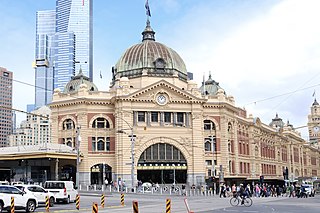
Flinders Street railway station is a train station located on the corner of Flinders and Swanston streets in Melbourne, Victoria, Australia. It is the second busiest train station in Australia, serving the entire metropolitan rail network, 15 tram routes travelling to and from the city, as well as some country and regional V/Line services to eastern Victoria. Opened in 1854, the station is the oldest in Australia, backing onto the Yarra River in the central business district, the complex includes 13 platforms and structures that stretch over more than two city blocks, from east of Swanston Street to nearly at Market Street.
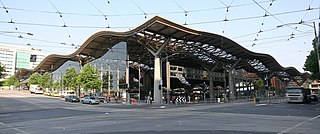
Southern Cross railway station is a major railway station in Docklands, Melbourne. It is on Spencer Street, between Collins and La Trobe streets, at the western edge of the Melbourne central business district. The Docklands Stadium sports arena is 500 metres north-west of the station.

The following is a timeline of the history of the city of Melbourne, Victoria, Australia.

Port Melbourne is an inner-city suburb in Melbourne, Victoria, Australia, 3 km (2 mi) south-west of the Melbourne central business district, located within the Cities of Melbourne and Port Phillip local government areas. Port Melbourne recorded a population of 17,633 at the 2021 census.

Southbank is an inner-city suburb in Melbourne, Victoria, Australia, 1 km south of the Melbourne central business district, located within the Cities of Melbourne and Port Phillip local government areas. Southbank recorded a population of 22,631 at the 2021 census.

The Port of Melbourne is the largest port for containerised and general cargo in Australia. It is located in Melbourne, Victoria, and covers an area at the mouth of the Yarra River, downstream of Bolte Bridge, which is at the head of Port Phillip, as well as several piers on the bay itself. Since 1 July 2003, the Port of Melbourne has been managed by the Port of Melbourne Corporation, a statutory corporation created by the State of Victoria.

The Sandridge Bridge is a historic bridge, originally carrying a railway, over the Yarra River in Melbourne, Victoria, Australia. It runs diagonally to the river's banks and is 178.4 metres (585 ft) long. In 2006 it was redeveloped as a pedestrian and cycle path featuring public art. It is the third bridge on the site and is listed on the Victorian Heritage Register.
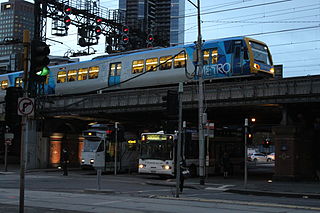
Transport in Melbourne, the state capital of Victoria, Australia, consists of several interlinking modes. Melbourne is a hub for intercity, intracity and regional travel. Road-based transport accounts for most trips across many parts of the city, facilitated by Australia's largest freeway network. Public transport, including the world's largest tram network, trains and buses, also forms a key part of the transport system. Other dominant modes include walking, cycling and commercial-passenger vehicle services such as taxis.

Princes Bridge, originally Prince's Bridge, is a bridge in central Melbourne, Australia that spans the Yarra River. It is built on the site of one of the oldest river crossings in the city, and forms a gateway into the central city from the south. The bridge connects Swanston Street on the north bank of the Yarra River to St Kilda Road on the south bank, and carries road, tram and pedestrian traffic. The present bridge was built in 1888 and is listed on the Victorian Heritage Register.
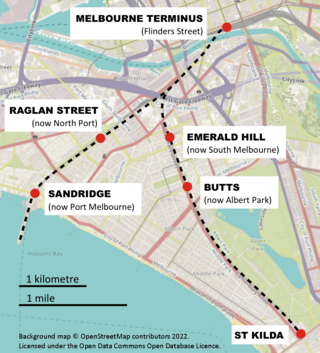
The Melbourne and Hobson's Bay Railway Company was a railway company in Victoria, Australia. The company was incorporated on 20 January 1853 to build the line from Melbourne to the port of Sandridge, now Port Melbourne.
The Port Melbourne railway line is a former railway line in Melbourne, Australia, opened in September 1854, that is now a light rail line. It was instigated by the Melbourne and Hobson's Bay Railway Company to carry passengers arriving in Victoria at Station Pier and to alleviate the high cost of shipping goods using small vessels up the Yarra River to Melbourne. The line's conversion to light rail occurred in 1987; it is now served by tram route 109.
The St Kilda railway line is a former railway line in Melbourne, Australia.
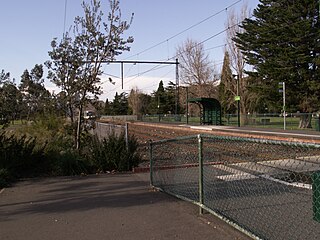
Graham Street is light rail station and former railway station on the former Port Melbourne railway line, in the inner Melbourne suburb of Port Melbourne, Victoria, Australia. Located to the north of Graham Street, between Evans Street and Station Street, the station has been demolished since 1987, and is now served by route 109 trams, stopping at a pair of low level platforms.

Beacon Cove is a light rail station in the Melbourne suburb of Port Melbourne located on the former Port Melbourne line, the first significant railway in Australia.

Montague Street is a light rail station and former railway station, on the former Port Melbourne railway line in the inner Melbourne suburb of South Melbourne, Australia. The station was located to the south of the Montague Street road underpass, between Woodgate Street and Gladstone Lane, with a large goods shed located on the Melbourne side of the station. The station buildings and platforms have been demolished, and there are now a pair of low-level platforms forming a tram stop on route 109.
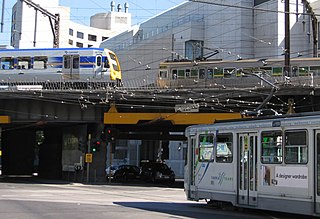
The Flinders Street Viaduct is a railway bridge in Melbourne, Australia. Made up of six tracks built at different times, it links Flinders Street station to Southern Cross station, forming the main connection between the eastern and western parts of the Victorian rail network.

Princes Pier is a 580 metre long historic pier on Port Phillip, in Port Melbourne, Victoria, Australia. It was known as the New Railway Pier until renamed Prince's Pier after the Prince of Wales who visited Melbourne in May 1920.

Jolimont Yard was an array of railway lines and carriage sidings on the edge of the central business district of Melbourne, Australia. Located between Flinders Street station, Richmond Junction, the Yarra River and Flinders Street they were often criticised for cutting off the city from the river, being the site of many redevelopment proposals. The Princes Gate Towers were built over part of the yard in the 1960s, which themselves were replaced by Federation Square in the 2000s. The rail sidings themselves were progressively removed from the 1980s to the 1990s with only running lines today, but the area continues to be referred to as the 'Jolimont railyards' by Melburnians.
The Wailing Wall is a section of brick retaining wall on the Flinders Street Extension, Melbourne, which is famous as the place where Wharf labourers who missed out on the daily work call would congregate.
North Port is a light rail station and a former railway station on Port Melbourne railway line, first significant railway in Melbourne, Australia. The station is located in the inner Melbourne suburb of Port Melbourne, Victoria, Australia. Though it was closed in 1987 for conversion to light rail, Melbourne tram route 109 now runs through the station with newly built low-floor platforms. The station was located to the south of Raglan Street and between Evans Street and Station Street.





















